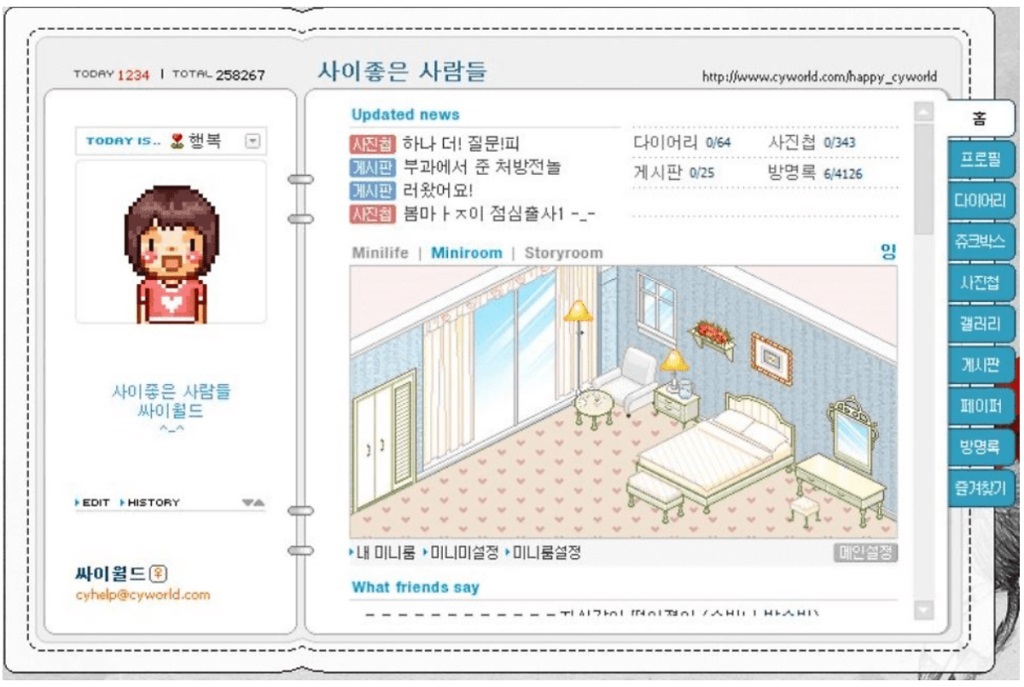Once-popular Cyworld aims to revive past glory with metaverse
A defining social network of pre-Facebook era, microblogging platform’s revival plan draws nostalgia, pessimism
By Yoon Min-sikPublished : Dec. 16, 2021 - 11:24

Long before the metaverse and cryptocurrency craze, South Korea had Cyworld, the microblogging platform where people used “dotori” digital money to decorate their personal avatars.
It didn’t just exist. It was rabidly popular, counting 32 million users out of the country’s population of 50 million at one point.
The once-mighty homegrown platform, however, became a relic of the past with the rise of Facebook, Twitter and the like. It suffered a similar fate to MySpace in the US.
This Friday, Cyworld will make its grand comeback as the metaverse platform “Cyworld Hancom Town,” downloadable via both Google and Apple’s app stores, as well as the local One Store, barring further hiccups in its plan.
The reincarnation of the first-generation social networking platform that ruled the mid-2000s South Korea is a collaborative effort by Cyworld Z, the old platform’s owner, and local software company Hancom Group.
News about Cyworld’s return has been tugging on the heartstrings of nostalgic Koreans, who saw billions of photos, videos, blog posts and the bond formed online with “ilchon” friends buried in the fall of the platform.
But in this era of TikTok and Instagram, Cyworld will need much more than just nostalgia. Will it still have appeal in this day and age, two decades removed from when it reigned supreme?
In hindsight, Cyworld was revolutionary
Cyworld began in 1999 as the graduation project of a Korea Advanced Institute of Science and Technology student. It was among several similar services launched by startups at the time, later defined as early forms of social networking services in the country.
Users of these platforms mostly comprised people in their teens and 20s, who sought to make friends via random chat rooms and online networking.
While some of its rivals focused on online community functions, Cyworld focused more on its “mini homepage,” a form of microblogging that allowed users to decorate a personal space on the virtual world with a “mini-me,” or the user’s digital avatar.
In fact, being a celebrated avatar in Cyworld cost some serious moolah, in the form of the cybercurrency “dotori,” which means acorn in Korean. Dotori was needed to decorate the designs of the characters and their virtual rooms, and to buy music and even fonts used in the mini homepage.
A 2003 acquisition by SK Communications granted the platform access to major funding. It also linked in SK’s instant messenger NateOn, allowing it to plow through the competition in the 2000s.
Cyworld, with its dotori, avatar and “ilchon” (a concept similar to followers on today’s social media), was a cultural phenomenon defining the mid-2000s.
In the movie “My Boss, My Teacher” -- the fourth most commercially successful movie of 2006 -- the protagonist hears that every kid wants “dotori” and mistakenly thinks this refers to actual acorns and hands them out to classmates, saying, “We are ilchon now.”
In another anecdote showing Cyworld’s immense influence at that time, local media carried articles about Konyang University Hospital in Daejeon in 2008 encouraging its workers to forge “ilchon” relationships with patients in order to make the hospital a friendlier place for patients.
How it failed
Created in Korea for Koreans, Cyworld had inherent limitations compared to the social media platforms that have since stood the test of time. Unlike Facebook, Twitter or Instagram, which provide international services, the platform’s service was divided by borders, making cross-country socializing virtually impossible.
Its link with local messenger service NateOn was eventually assessed as a bad move, as the messenger service was later almost driven out of the market by the mobile messenger king of South Korea, KakaoTalk.
Professor Kim Kyung-hee of Hallym University’s Media School compared what she deemed successful and failed cases of social media -- Facebook and KakaoTalk being the former and Cyworld being the latter -- in her 2019 study and pointed out that Cyworld’s failure to reflect the changes in users’ needs and environment led to its downfall.
“Late reaction to the mobile era was cited (by those in the industry) as a reason for failure ... particularly Cyworld being unable to adapt to changes in the media that was sparked by mobile devices like iPhone,” she wrote. Kim added that many workers of Cyworld who she interviewed quoted the complex -- and often belated -- decision-making process of a large conglomerate as to why the platform had such trouble expanding its structure.
Lee Dong-hyung, co-founder of Cyworld and its CEO until 2008, said in a past interview that the company was fixated on selling dotori, locking its immense potential as a social media business to that simple business model. In 2009, 43 percent of SK Communication’s second-quarter profits came from dotori sales.
Cyworld’s system, while revolutionary at the time, never evolved beyond its initial form. Although dotori had introduced the idea of a cybercurrency to many Koreans, the platform never ventured deep into the idea of online commerce. The mini homepage was never really transferred to smartphones, nor were its other services.
A metaverse makeover
In the stock market, Cyworld’s return is generating anticipation, with related shares spiking. NHN Bugs had seen its shares rise from 6,220 won to well over 20,000 won as of Wednesday, in the span of four months since announcing it will provide music for the new platform and applications.
“The Cyworld of the past was a service selling dotori (to users), but the new Cyworld will be a system where the users become creators who will play an active role in the financial activities,” a Cyworld official was quoted as saying.

According to the company, the mini homepage, avatar characters, mini-room and other functions of the original platform will be provided but in a 3D format, providing the metaverse environment to users. The company has released images of 3D virtual spaces as well as the user interface of the soon-to-be unveiled Cyworld Hancom Town.
It will also allow various commercial services and business functions like virtual offices and videoconferencing.
For users of the original Cyworld, the firm has managed to revive some 18 billion photos and 150 million videos that had been previously uploaded.
“We will provide a metaverse environment in which our users could shop, use the bank and buy movie tickets,” Cyworld Z CEO Son Sung-min told the media.
With specifics about the platform yet to be released, it is still uncertain whether the new Cyworld will manage to revive its past glory.



















![[Today’s K-pop] Treasure to publish magazine for debut anniversary](http://res.heraldm.com/phpwas/restmb_idxmake.php?idx=642&simg=/content/image/2024/07/26/20240726050551_0.jpg&u=)